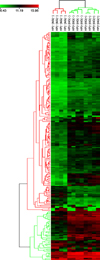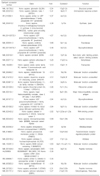Abstract
Purpose
Nodular gastritis is a characteristic finding of Helicobacter pylori infection in children. The aim of this study was to evaluate the difference in gene expression in the gastric mucosa of H. pylori-infected and non-infected children, and to analyze the difference in gene expression using cDNA microarray analysis of nodular gastritis caused by H. pylori infection.
Methods
Twelve children (6 boys and 6 girls; mean age 9.8 years) who underwent upper gastrointestinal endoscopy and biopsy at Seoul National University Bundang Hospital were included in the study. The subjects were divided into three groups according to the presence of H. pylori infection and nodular gastritis on endoscopic examination. Gastric mucosa tissue was kept at -70℃ and RNA was extracted to perform cDNA microarray analysis in each patient.
Results
cDNA microarray analysis in children revealed a clear distinction between H. pylori-infected and non-infected gastric mucosa. Specifically, 182 over-expressed genes and 29 under-expressed genes were identified in H. pylori-infected gastric mucosa compared to non-infected mucosa. H. pylori-infected nodular gastritis revealed different gene expression patterns from H. pylori-infected normal gastric mucosa; five genes were over-expressed and five genes were under-expressed.
Conclusion
In the presence of H. pylori infection, gastric mucosa shows distinct differences in gene expression, and nodular gastritis with H. pylori infection in children may be associated with over- or under-expression of some genes. Further studies are required to clarify the host response and the pathogenesis of nodular gastritis in children.
Figures and Tables
Fig. 1
Hierarchical clustering of 37,351 genes expressed in the gastric mucosa of children in 3 groups based on the presence of Helicobacter pylori infection (HP) and nodular gastritis (NG). The red color indicates over-expressed genes and the green color indicates under-expressed genes.

Table 1
List of Genes Over-expressed in the Gastric Mucosa of Helicobacter pylori-infected Children Compared to Non-infected Gastric Mucosa

References
1. Drumm B. Helicobacter pylori in the pediatric patient. Gastroenterol Clin North Am. 1993. 22:169–182.
2. Lindkvist P, Asrat D, Nilsson I, Tsega E, Olsson GL, Wretlind B, et al. Age at acquisition of Helicobacter pylori infection: comparison of a high and low prevalence country. Scand J Infect Dis. 1996. 28:181–184.

3. O'Donohoe JM, Sullivan PB, Scott R, Rogers T, Brueton MJ, Barltrop D. Recurrent abdominal pain and Helicobacter pylori in a community-based sample of London children. Acta Pediatr. 1996. 85:961–964.
4. Valle J, Kekki M, Sipponen P, Ihamäki T, Siurala M. Long-term course and consequences of Helicobacter pylori gastritis. Results of a 32-year follow-up study. Scand J Gastroenterol. 1996. 31:546–550.

5. Prieto G, Polanco I, Larrauri J, Rota L, Lama R, Carrasco S. Helicobacter pylori infection in children: clinical, endoscopic, and histologic correlations. J Pediatr Gastroenterol Nutr. 1992. 14:420–425.
6. Miyamoto M, Haruma K, Yoshihara M, Hiyama T, Sumioka M, Nishisaka T, et al. Nodular gastritis in adults is caused by Helicobacter pylori infection. Dig Dis Sci. 2003. 48:968–975.
7. Wen S, Felley CP, Bouzourene H, Reimers M, Michetti P, Pan-Hammarström Q. Inflammatory gene profiles in gastric mucosa during Helicobacter pylori infection in humans. J Immunol. 2004. 172:2595–2606.

8. Mannick E, Schurr JR, Zapata A, Lentz JJ, Gastanaduy M, Cote RL, et al. Gene expression in gastric biopsies from patients infected with Helicobacter pylori. Scand J Gastroenterol. 2004. 39:1192–1200.

9. Ohara H, Isomoto H, Wen CY, Ejima C, Murata M, Miyazaki M, et al. Expression of mucosal addressin cell adhesion molecule 1 on vascular endothelium of gastric mucosa in patients with nodular gastritis. World J Gastroenterol. 2003. 9:2701–2705.

10. Dixon MF, Genta RM, Yardley JH, Correa P. Classification and grading of gastritis: the updated Sydney system. International Workshop on the Histopathology of Gastritis, Houston 1994. Am J Surg Pathol. 1994. 20:1161–1181.
11. Sambrook J, Fritsch EF, Maniatis T. Molecular cloning: a laboratory manual. 1989. 2nd ed. Plainview, NY: Cold Spring Harbor Laboratory Press;E3–E4.
12. Seo JK, Ko JS, Choi KD. Serum ferritin and Helicobacter pylori infection in children: A seroepidemiologic study in Korea. J Gastroenterol Hepatol. 2002. 17:754–757.

13. Kim JH, Kim HY, Kim NY, Kim SW, Kim JG, Kim JJ, et al. Seroprevalence of Helicobacter pylori ingection in asymptomatic people in Korea. Korean J Med. 2000. 59:388–397.
14. Seo JK, Sim JG, Kim EJ. Serologic diagnosis of Helicobacter pylori gastritis in children: Seroepidemiology of H. pylori in normal school children and diagnostic accuracy of IgG GAP test in children with gastrointestinal symptoms. Korean J Gastrointest Endosc. 1993. 13:673–684.
15. Choe YH, Kim EC, Seo JK. Seroepidemiology of H. pylori infection in normal preschool children. Korean J Pediatr Gastroenterol Nutr. 1999. 2:147–152.

16. Ganga-Zandzou PS, Michaud L, Vincent P, Guimber D, Turck D, Gottrand F. Natural outcome of Helicobacter pylori infection in asymptomatic children: two-year follow-up study. Pediatrics. 1999. 104:216–221.

17. Bahu MG, da Silveira TR, Maguilnick I, Ulbrich-Kulczynski J. Endoscopic nodular gastritis: an endoscopic indicator of high-grade bacterial colonization and severe gastritis in children with Helicobacter pylori. J Pediatr Gastroenterol Nutr. 2003. 36:217–222.
18. Sepulveda AR, Tao H, Carloni E, Sepulveda J, Graham DY, Peterson LE. Screening of gene expression profiles in gastric epithelial cells induced by Helicobacter pylori using microarray analysis. Aliment Pharmacol Ther. 2002. 16:Suppl 2. 145–157.

19. Bach S, Makristathis A, Rotter M, Hirschl AM. Gene expression profiling in AGS cells stimulated with Helicobacter pylori isogenic strains (cagA positive or cagA negative). Infect Immun. 2002. 70:988–992.

20. Kim NY, Park WY, Kim JM, Park YS, Lee DH, Park JH, et al. Analysis of gene expression profile of AGS cells stimulated by Helicobacter pylori adhesion. Gut and liver. 2007. 1:40–48.
21. Riddell RH. Pathobiology of Helicobacter pylori infection in children. Can J Gastroenterol. 1999. 13:599–603.




 PDF
PDF ePub
ePub Citation
Citation Print
Print




 XML Download
XML Download